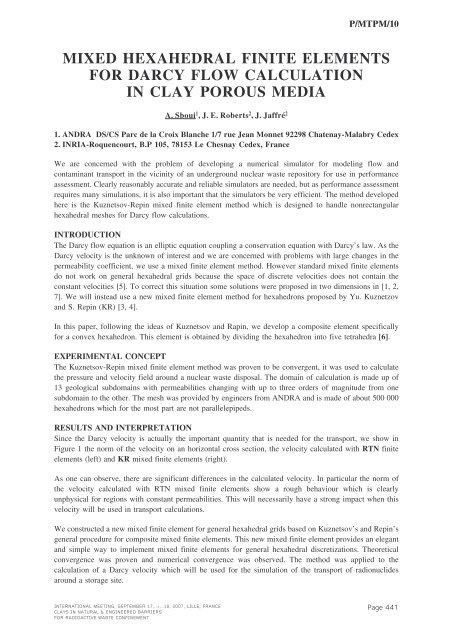Mass Transfer & Porous Media (MTPM) - Andra
Mass Transfer & Porous Media (MTPM) - Andra
Mass Transfer & Porous Media (MTPM) - Andra
Create successful ePaper yourself
Turn your PDF publications into a flip-book with our unique Google optimized e-Paper software.
P/<strong>MTPM</strong>/10MIXED HEXAHEDRAL FINITE ELEMENTSFOR DARCY FLOW CALCULATIONIN CLAY POROUS MEDIAA. Sboui 1 , J. E. Roberts 2 , J. Jaffré 21. ANDRA DS/CS Parc de la Croix Blanche 1/7 rue Jean Monnet 92298 Chatenay-Malabry Cedex2. INRIA-Roquencourt, B.P 105, 78153 Le Chesnay Cedex, FranceWe are concerned with the problem of developing a numerical simulator for modeling flow andcontaminant transport in the vicinity of an underground nuclear waste repository for use in performanceassessment. Clearly reasonably accurate and reliable simulators are needed, but as performance assessmentrequires many simulations, it is also important that the simulators be very efficient. The method developedhere is the Kuznetsov-Repin mixed finite element method which is designed to handle nonrectangularhexahedral meshes for Darcy flow calculations.INTRODUCTIONThe Darcy flow equation is an elliptic equation coupling a conservation equation with Darcy’s law. As theDarcy velocity is the unknown of interest and we are concerned with problems with large changes in thepermeability coefficient, we use a mixed finite element method. However standard mixed finite elementsdo not work on general hexahedral grids because the space of discrete velocities does not contain theconstant velocities [5]. To correct this situation some solutions were proposed in two dimensions in [1, 2,7]. We will instead use a new mixed finite element method for hexahedrons proposed by Yu. Kuznetzovand S. Repin (KR) [3, 4].In this paper, following the ideas of Kuznetsov and Rapin, we develop a composite element specificallyfor a convex hexahedron. This element is obtained by dividing the hexahedron into five tetrahedra [6] .EXPERIMENTAL CONCEPTThe Kuznetsov-Repin mixed finite element method was proven to be convergent, it was used to calculatethe pressure and velocity field around a nuclear waste disposal. The domain of calculation is made up of13 geological subdomains with permeabilities changing with up to three orders of magnitude from onesubdomain to the other. The mesh was provided by engineers from ANDRA and is made of about 500 000hexahedrons which for the most part are not parallelepipeds.RESULTS AND INTERPRETATIONSince the Darcy velocity is actually the important quantity that is needed for the transport, we show inFigure 1 the norm of the velocity on an horizontal cross section, the velocity calculated with RTN finiteelements (left) and KR mixed finite elements (right).As one can observe, there are significant differences in the calculated velocity. In particular the norm ofthe velocity calculated with RTN mixed finite elements show a rough behaviour which is clearlyunphysical for regions with constant permeabilities. This will necessarily have a strong impact when thisvelocity will be used in transport calculations.We constructed a new mixed finite element for general hexahedral grids based on Kuznetsov’s and Repin’sgeneral procedure for composite mixed finite elements. This new mixed finite element provides an elegantand simple way to implement mixed finite elements for general hexahedral discretizations. Theoreticalconvergence was proven and numerical convergence was observed. The method was applied to thecalculation of a Darcy velocity which will be used for the simulation of the transport of radionuclidesaround a storage site.INTERNATIONAL MEETING, SEPTEMBER 17...>...18, 2007, LILLE, FRANCECLAYS IN NATURAL & ENGINEERED BARRIERSFOR RADIOACTIVE WASTE CONFINEMENTPage 441
















